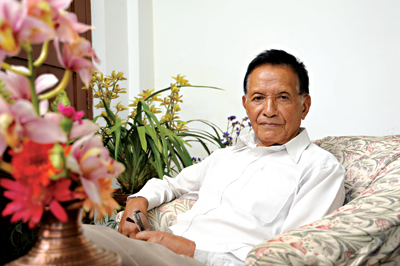With a gentle voice, Rajendraji meets us at the front of his Parijat orchid farm, in Godawari. A slight English twang, underlines his accent. These are Cymbidium Orchids, he says, as he points to a poly tunnel, filled, with those of Japanese and Korean origin. October/November will be the time to see them bloom in seven colors.
 The sun is high over the nursery and so Rajendra invites us into his home, for mid-day tea. As we walk, I am pointed to other items he grows here, roses and kiwis down to the left, peaches high on the right, and carnation flowers along the walkway. In calm spoken English, my host describes how it was his wife who was interested in flowers, “I was a teacher, a headmaster in Hong Kong. But upon retirement, we decided to invest in the farm.”
The sun is high over the nursery and so Rajendra invites us into his home, for mid-day tea. As we walk, I am pointed to other items he grows here, roses and kiwis down to the left, peaches high on the right, and carnation flowers along the walkway. In calm spoken English, my host describes how it was his wife who was interested in flowers, “I was a teacher, a headmaster in Hong Kong. But upon retirement, we decided to invest in the farm.”
As tea is poured, with the leaves coming from his home-place in Ilam, eastern Nepal, Rajendra talks about 15 years spent in Hong Kong, as Principal of the school for Gurkha children; how he fought for a better and equal pay, and won, getting rates improved, not just for his school, but also for schools in Singapore, Sikkim and Dharan.
A young Japanese lady appears, at the door and briefly shares tea; she is volunteering at the farm. Actually, there is a lot of co-operation with the Japanese, in this industry. Offered next are some sweet cakes and biscuits, the entire teatime affair, reflecting his years in Hong Kong, with the Gurkha School and the British.
It seems Rajendra has always been a man willing to get down to see changes, and advances. His was one of the first voices, calling for the creation, 15 years ago, of Nepal’s now-expanding flower market. Back then, he recalls people laughed, it was just flowers from the garden, for temples. Then the Floriculture Association of Nepal came about and today, the domestic market of Kathmandu is booming, and the international market is starting to take off, to Qatar and Dubai primarily—especially with Cymbidiums.
Two orchids are blooming in the room as we talk, giving a focus to our conversation. Rajendra describes how there are more than 400 varieties of the plant, and the weather of Kathmandu, Ilam and Dhankuta are perfect for Cymbidiums, while places like Pokhara are perfect for more tropical versions. The Cymbidiums come in up to seven colors, but the most popular ones are green, yellow red and pink, with the export being the cut flower itself. The plant takes two and a half years to flower, but as he says, I have one that is 35 years old!
In his battle with making investors and the government understand, Rajendra pointed that growing one Cymbidium is worth the equivalent of 20 other cut flowers. Today the government is assisting with 50% subsidies, under the one village, one product scheme. Kathmandu is now home to over 500 nurseries.
Rajendra’s struggle is bearing fruit, as the development of Nepal’s horticultural industry is well on pace, while Ilam is starting too and the situation in Dhankuta looks positive. As I leave the nursery, I meet the lady responsible for it all, Rajendra’s wife, sitting with a content glow, with other ladies, going about potting Cymbidiums. Rajendra explains how many of the ladies who worked for him now run small nurseries themselves, as they too saw the benefits, and on a whole the co-operative of 15 odd growers, just in Godawari, is now much stronger and can accept even larger orders.









